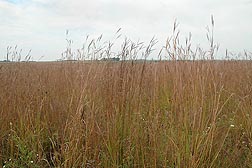This page has been archived and is being provided for reference purposes only. The page is no longer being updated, and therefore, links on the page may be invalid.
| Read the magazine story to find out more. |
|
|
|
|
Prairie Restoration Also Helps Restore Water Quality
By Ann PerryFebruary 28, 2012
U.S. Department of Agriculture (USDA) scientists are studying the overall improvement in water quality when native prairie vegetation is restored to fields once cropped with corn and soybeans. Agricultural Research Service (ARS) scientists in Ames, Iowa, were part of a team that examined changes in groundwater during prairie establishment at the Neal Smith National Wildlife Refuge near Prairie City, Iowa. ARS is USDA's chief intramural scientific research agency.
ARS researchers Mark Tomer and Cynthia Cambardella work at the agency's National Laboratory for Agriculture and the Environment in Ames. Their group studied concentrations of nitrates and phosphorus in groundwater in a 17-acre field that was being converted from corn and soybean row-cropping into a reconstructed prairie. The researchers set up groundwater monitoring wells and collected water samples from 2002 through 2009.
After a final soybean harvest in 2003, the field was seeded with native grasses and forbs. As the prairie became established, nitrate concentrations in groundwater samples declined and stabilized within five years. Initially, nitrate levels in groundwater samples taken at higher slopes averaged 10.6 parts per million (ppm), levels that can fuel the downstream development of the "dead zone" in the Gulf of Mexico.
But nitrate levels in groundwater samples taken near surface waterways averaged only 2.5 ppm, and after 2006, nitrates disappeared from the shallow groundwater near the waterways. Further upslope, groundwater samples still had measurable nitrate levels in 2006, but levels diminished to around 2 ppm after 2007.
Unlike nitrate, however, phosphorus levels did not decline. Between 2006 and 2009, phosphorus concentrations averaged 0.14 ppm along the ephemeral waterways, while average upland concentrations were only around 0.02 ppm. The higher phosphorus concentrations were found in shallow groundwater wells adjacent to grass waterways. When groundwater levels rose enough to produce overland flows that contribute to stream flow, the phosphorus concentrations were high enough to threaten local water quality.
Results from this study were published in Agriculture, Ecosystems and Environment.
Read more about the research in the February 2012 issue of Agricultural Research magazine.

